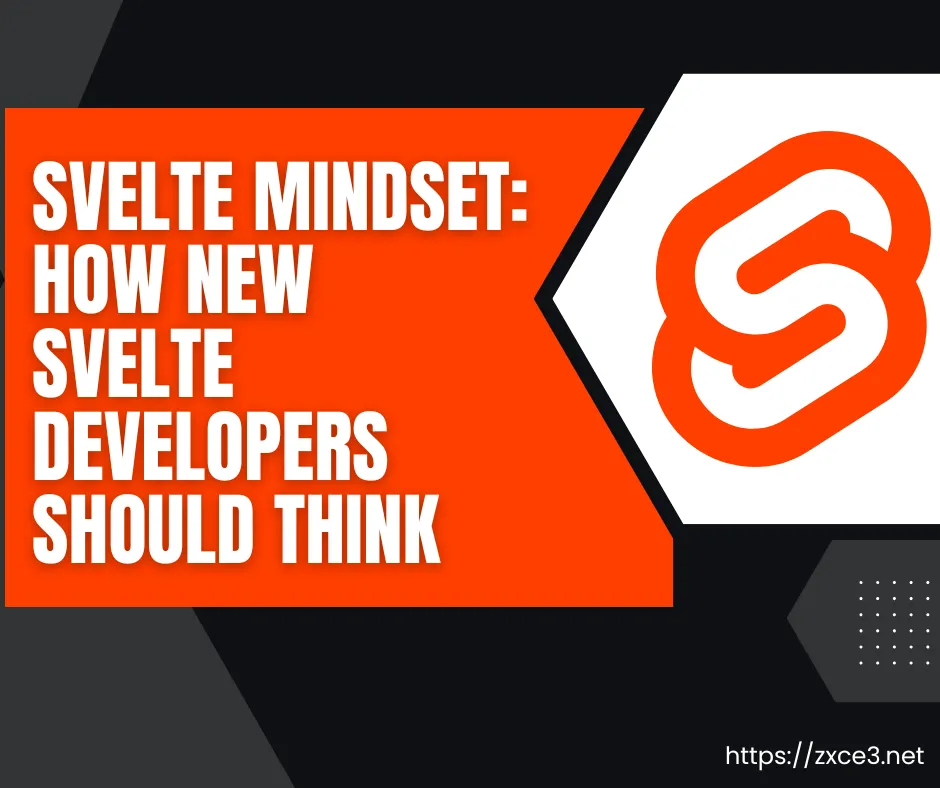Introduction
Svelte has been making waves in the web-development community, not as a framework in the traditional sense like React or Vue, but as a compiler that offers a radically different approach to building web apps. If you’re new to Svelte, adopting the Svelte Mindset is key to unlocking its full potential and enjoying its unique benefits.
This post will guide you through the principles and mindset that new Svelte developers should adopt, helping you think like a true Svelte developer.
Think Simplicity, Not Complexity
One of Svelte’s biggest selling points is its simplicity. Unlike other frameworks that often require lots of boilerplate code, state management tools, and complex lifecycle methods, Svelte promotes a clean and minimalistic approach.
- Embrace reactivity as a first-class citizen: In Svelte, you don’t need complex state libraries or hooks. A simple assignment like
let count = 0and updatingcount += 1will automatically re-render your component. This natural reactivity is something to lean into.
<script>
let count = 0;
</script>
<button on:click={() => count++}>Clicked {count} times</button>Svelte mindset: Focus on writing declarative code. You don’t need to orchestrate complicated updates—just let Svelte do the work behind the scenes.
Components as Functions, Not Classes
In Svelte, components are more like functions than classes. Each component can take in props, render markup, and manage its internal state—all without the need for complex inheritance or decorators.
- No more lifecycle methods: Svelte reduces the need for verbose lifecycle methods like
componentDidMountoruseEffect. Instead, you can just use reactive declarations and reactive statements ($:) to automatically respond to changes.
<script>
let name = 'world';
$: console.log(`Hello, ${name}`);
</script>
<input bind:value={name} />
<p>Hello {name}!</p>Svelte mindset: Components are simple, functional blocks of logic. If a piece of code depends on a variable, just write it directly—there’s no need for extra ceremony.
Reactivity without Re-rendering
Svelte’s reactivity model is one of its most powerful features. Rather than tracking virtual DOM diffs and re-rendering entire components like in React or Vue, Svelte compiles components down to efficient imperative JavaScript that updates only the parts of the DOM that change.
- No virtual DOM: Svelte doesn’t use a virtual DOM, meaning it’s faster in many cases and lighter in terms of resource consumption. When a piece of reactive state changes, Svelte directly updates the specific DOM element associated with that state.
Svelte mindset: Think small and focused. Focus on specific DOM updates rather than the entire component’s structure. This leads to leaner, more efficient apps.
Write Less, Do More
One of the core philosophies of Svelte is to help developers write less code while still accomplishing complex behaviors. This is achieved through a combination of concise syntax, reactive variables, and built-in animation and transitions.
- Built-in features: Svelte comes with many built-in features like transitions, animations, scoped CSS, and stores (for state management across components). This means you can create powerful interactions without importing third-party libraries or writing a lot of boilerplate code.
Example: Adding a simple fade transition in Svelte:
<script>
let visible = true;
</script>
<button on:click={() => visible = !visible}>
Toggle Visibility
</button>
{#if visible}
<p transition:fade>This will fade in and out!</p>
{/if}Svelte mindset: Use what’s built-in. Trust that Svelte provides many features out-of-the-box that reduce the need for extra libraries or complex logic.
Store State Globally with Ease
In larger applications, managing state across components becomes important. Svelte’s built-in stores provide a simple, declarative way to manage shared state across components, with no extra packages required.
- Writable and readable stores: Svelte offers different types of stores, like writable stores for state that can be updated and readable stores for read-only data.
Example: Using a writable store:
// store.js
import { writable } from 'svelte/store';
export const count = writable(0);<script>
import { count } from './store.js';
</script>
<button on:click={() => $count++}>
Clicked {$count} times
</button>Svelte mindset: State management doesn’t need to be complex. Leverage Svelte stores to share and update state across your app without third-party dependencies.
CSS Scoping Without the Hassle
Styling in Svelte is scoped to the component by default, meaning you don’t have to worry about naming collisions or complex CSS rules. This makes styling easier, and you can still use global styles when needed.
- Scoped styles: Any CSS you write in a Svelte component is scoped to that component, meaning it only applies to the elements in that specific file.
Example: Scoped CSS in a Svelte component:
<style>
p {
color: blue;
}
</style>
<p>This text will be blue!</p>Svelte mindset: Write your styles naturally without worrying about scoping. The styles will stay within the component unless explicitly defined as global.
Compile-Time Optimization
One of the core differentiators of Svelte is that it’s a compiler rather than a framework. This means when you build your app, Svelte turns your components into highly optimized vanilla JavaScript, resulting in smaller, faster applications.
- No runtime: Since Svelte compiles components at build time, the overhead of a framework like React or Vue doesn’t exist in your production app.
Svelte mindset: Trust the compiler. Svelte takes care of a lot of optimization at compile time, meaning you don’t have to worry about performance tweaks like you would with other frameworks.
Conclusion
Svelte’s unique approach requires a slight mindset shift from more traditional frameworks. The key takeaway is to embrace simplicity. Let the framework’s reactive nature and compiler handle the heavy lifting while you focus on writing clean, efficient, and declarative code. By adopting the Svelte Mindset, you’ll find yourself writing less boilerplate, optimizing effortlessly, and building more intuitive applications.
If you’re new to Svelte, take time to experiment with these ideas, and you’ll quickly discover how enjoyable and productive Svelte development can be.
Further Reading
- “Svelte and Sapper in Action” by Mark Volkmann.
- “Svelte: The Complete Guide” by Simon Holthausen.

